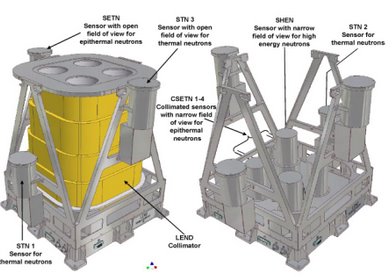Neutrons from the Moon are produced in the subsurface layer of 1–2 m of regolith due to bombardment by galactic cosmic rays (GCR). These secondary neutrons diffuse in the subsurface material and interact with soil nuclei with the emission of nuclear gamma-rays. All celestial bodies without a thick atmosphere, like the Moon, Mars, Mercury, and asteroids, produce secondary neutron emission. Neutrons from these celestial bodies have a range of energies. Original high energy neutrons produced by GCR have energies about tens of MeV. In each collision with nuclei, neutrons lose some fraction of their energy, and many of them are moderated down to the thermal energy of the regolith. Other neutrons escape before being thermalized and have some intermediate energy between tens of MeV and the regolith thermal energy.
It is known that higher hydrogen content in the soil leads to faster moderation of neutrons, and therefore decreases the fraction of leaking epithermal neutrons and correspondingly increases the fraction of leaking thermal neutrons. The presence of 100 ppm of hydrogen in the lunar regolith would lead to a decrease of epithermal neutron flux by about 5% in comparison to the absence of hydrogen. Therefore, mapping the epithermal neutron emissions of the Moon is the most powerful method to determine the distribution of hydrogen in the shallow subsurface of the Moon (up to 1–2 meters). Evidence for lunar polar depression of epithermal neutron flux from the Lunar Prospector has two alternative interpretations: the first attributes depression of epithermal neutrons to water-ice deposits at in permanently shadowed craters, the other interpretation explains polar neutron depression as the enhancement of hydrogen implanted from solar wind due to a slow diffusion process at low polar temperatures.
The Lunar Exploration Neutron Detector’s (LEND’s) most important attribute is that it is capable of providing high spatial resolution mapping of epithermal neutrons with collimated epithermal neutron detectors (see detectors CSETN 1–4 in Fig. 1). LEND is able to detect a hydrogen-rich spot at one of the Lunar poles with as little as 100 ppm of hydrogen and a spatial resolution of 10 km (pixel diameter), and to produce global measurements of the hydrogen content with a resolution of 5–20 km. If the hydrogen is associated with water, a detection limit of 100 ppm hydrogen corresponds to ∼ 0.1% weight water ice in the regolith. High energy neutron data from another LEND sensor (SHEN in Fig. 1) could help to distinguish between areas in which hydrogen was implanted by solar wind and potential water ice deposits. However, the most conclusive results from the reconnaissance of lunar water/hydrogen resources would come from the joint analysis of all the five mapping science instruments onboard : DLRE, LAMP, LEND, LOLA and LROC.
Fig. 1 LEND Design Concept
LEND’s primary sensor type is the 3He counter, used for LEND detectors CSETN 1–4, STN 1–3, and SETN. The 3He counter produces an electrical pulse proportional to the number of ions formed. The Cd shield around CSETN 1–4 and SETN absorbs all neutrons with energies below ∼0.4 eV, which exclude all thermal neutrons from detection. Collimating modules around the 3He counters of CSETN 1–4 effectively absorb neutrons that have large angles with respect to the normal on the Moon’s surface (Fig. 1), leading to spatial resolution of 10 km full width at half maximum signal from the nominal 50 km orbit. LEND’s set of 8 different detectors with 3He counters (4 of which have collimators) and one stilbene scintillator will provide the observational data necessary for global mapping of the hydrogen content on the lunar surface, with a spatial resolution of 5 km radius at the poles[8].
